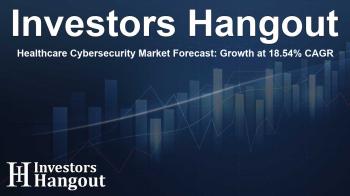Healthcare Cybersecurity Market Forecast: Growth at 18.54% CAGR

Healthcare Cybersecurity Market Overview
The healthcare cybersecurity market is experiencing remarkable growth, expected to increase significantly from a valuation of USD 20.56 billion to around USD 112.6 billion over the upcoming years, which indicates a robust compound annual growth rate (CAGR) of 18.54%. This surge is largely driven by the rising number of cyberattacks targeting healthcare organizations and the stringent regulations that govern the protection of patient data.
Market Drivers and Dynamics
As healthcare organizations increasingly leverage digital platforms for managing sensitive patient data, the threats to this information have also multiplied. Cybercriminals target hospitals and clinics due to the high value of medical data, leading to increased demand for advanced cybersecurity solutions. Government mandates such as HIPAA require strict compliance, further propelling the need for robust cybersecurity measures.
Rising Cyber Threats
The healthcare sector faces a unique challenge from escalating cyber threats including ransomware, phishing, and advanced persistent threats. The severity and frequency of these attacks necessitate a proactive approach to cybersecurity. Hospitals are finding themselves at the forefront of these cyber battles, compelled to enhance their defenses.
Technological Innovations Impacting Cybersecurity
Innovations in cybersecurity technology, including the integration of artificial intelligence, machine learning, and blockchain, are revolutionizing how healthcare organizations approach cybersecurity. These technologies improve real-time threat monitoring and automate incident response processes, enabling institutions to secure sensitive data more effectively.
Market Segmentation and Regional Insights
The healthcare cybersecurity market can be segmented by type of service, type of threat, and end-use. Recently, North America held a substantial share of the market, accounting for 40% in 2024. The region's advanced healthcare infrastructure and proactive regulatory environment support its dominant position.
North America: Leading the Charge
The U.S. healthcare system's investment in cybersecurity technologies is a significant driver of market growth. Institutions continually prioritize funding for antivirus solutions, intrusion detection, and prevention systems, aiding in robust defense against cyber threats.
Asia-Pacific: The Fastest Growing Region
In contrast, the Asia-Pacific region is anticipated to exhibit the highest CAGR during the forecast period. The ongoing digital transformation of healthcare facilities, coupled with an increase in telemedicine adoption, enhances the urgency for effective cybersecurity approaches within this region.
Market Challenges and Risks
Healthcare organizations face numerous challenges in combating cyber threats. Issues such as outdated legacy systems, inadequate cybersecurity budgets, and the complexity of regulatory landscapes often hinder effective implementation of necessary security measures. Additionally, the rise of connected devices in healthcare presents new vulnerabilities that need addressing.
Increasing Importance of Data Protection Compliance
Compliance with regulations like HIPAA necessitates that healthcare providers adopt robust security measures. As healthcare continues to evolve towards technologically integrated solutions, adherence to these regulations while ensuring patient data privacy remains paramount.
Future Outlook for Healthcare Cybersecurity
The future of the healthcare cybersecurity market is promising, fueled by ongoing innovations and a growing awareness of the critical need for security. Investments in cutting-edge cybersecurity technologies will be vital for safeguarding healthcare organizations against the persistent threat landscape.
Frequently Asked Questions
What is driving the growth of the healthcare cybersecurity market?
The growth is primarily driven by increased cyberattacks on healthcare organizations and the need for compliance with regulations designed to protect sensitive patient information.
How significant is the projected growth in the healthcare cybersecurity market?
The market is projected to increase from USD 20.56 billion to USD 112.6 billion by 2034, reflecting a compound annual growth rate of 18.54%.
What types of cyber threats are most prevalent in healthcare?
Healthcare organizations face threats such as ransomware, phishing attacks, and advanced persistent threats, all targeting sensitive data and systems.
Which regions are leading in market growth?
Currently, North America is the leader in market share, while the Asia-Pacific region is expected to experience the fastest growth rate in the coming years.
What challenges do healthcare organizations face regarding cybersecurity?
Key challenges include outdated legacy systems, budget constraints, complex compliance requirements, and the growing risks associated with connected medical devices.
About The Author
Contact Logan Wright privately here. Or send an email with ATTN: Logan Wright as the subject to contact@investorshangout.com.
About Investors Hangout
Investors Hangout is a leading online stock forum for financial discussion and learning, offering a wide range of free tools and resources. It draws in traders of all levels, who exchange market knowledge, investigate trading tactics, and keep an eye on industry developments in real time. Featuring financial articles, stock message boards, quotes, charts, company profiles, and live news updates. Through cooperative learning and a wealth of informational resources, it helps users from novices creating their first portfolios to experts honing their techniques. Join Investors Hangout today: https://investorshangout.com/
The content of this article is based on factual, publicly available information and does not represent legal, financial, or investment advice. Investors Hangout does not offer financial advice, and the author is not a licensed financial advisor. Consult a qualified advisor before making any financial or investment decisions based on this article. This article should not be considered advice to purchase, sell, or hold any securities or other investments. If any of the material provided here is inaccurate, please contact us for corrections.

